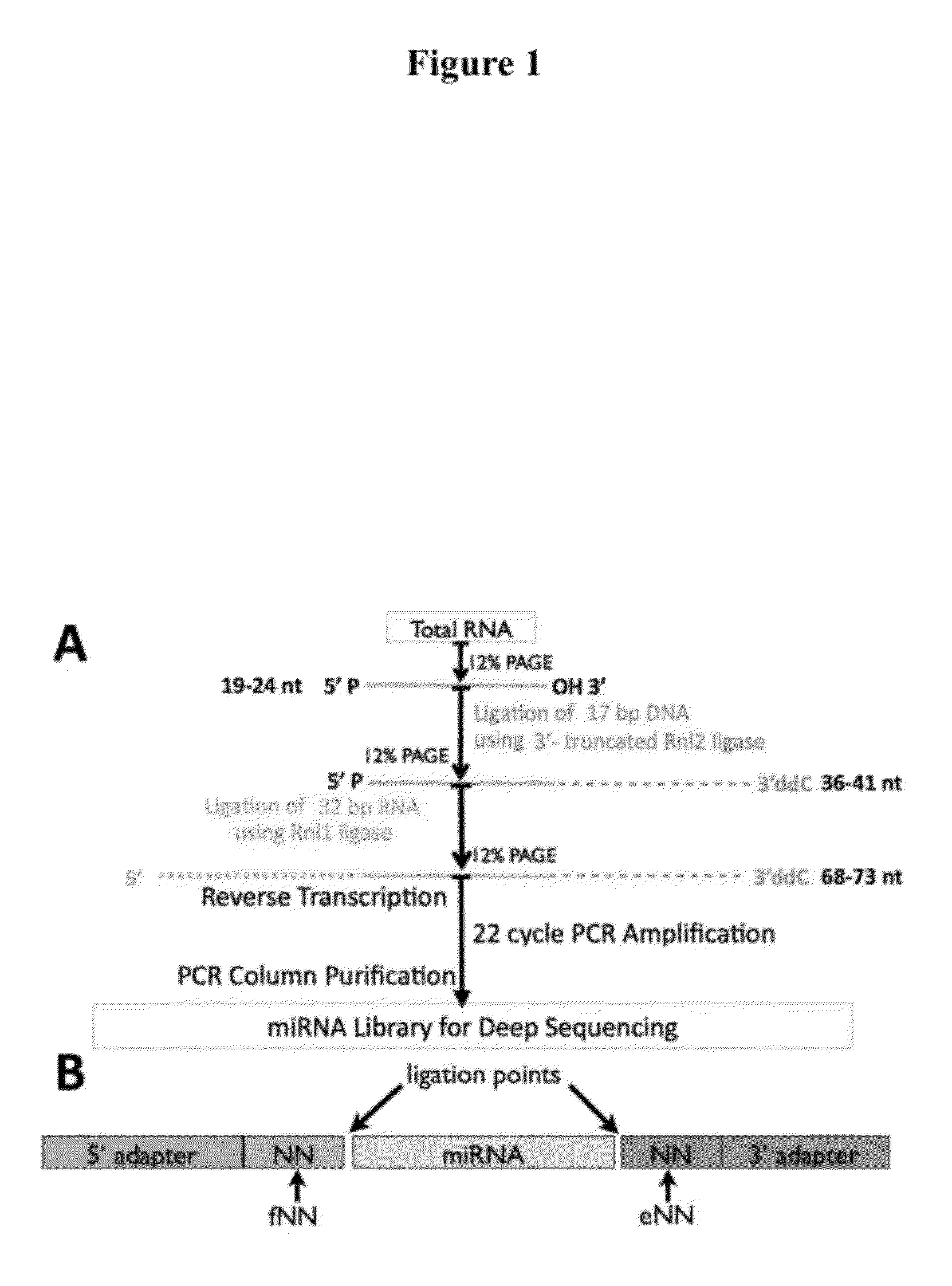Pooled adapter strategy for reducing bias in small RNA characterization
a technology of adapter and characterization, which is applied in the field of deep sequencing approaches, can solve the problems of reducing the sensitivity and accuracy of deep sequencing, erroneous conclusions, and undermining the incredible sensitivity and accuracy made possible by deep sequencing, so as to reduce accurate profile the small rna transcriptome. , the effect of reducing the bias in rna libraries
- Summary
- Abstract
- Description
- Claims
- Application Information
AI Technical Summary
Benefits of technology
Problems solved by technology
Method used
Image
Examples
example 1
[0052]This Example provides a disclosure of the materials and methods used in conducting the experiments disclosed in the remaining working examples.
ES Cell Culture
[0053]R1 mouse ES cell line was cultured feeder-free on 0.1% gelatin-coated plates in DMEM; Hi-Glucose, 15% fetal bovine serum, non-essential amino acids, L-glutamine, β-mercaptoethanol, penicillin / streptomycin, sodium pyruvate and leukemia inhibitory factor (LIF). Cells were grown in a humidified incubator in 5% C02 and 95% air. These cells were kindly donated by the Lemischka laboratory at Mount Sinai School of Medicine.
Library Construction and Sequencing
[0054]Total RNA was isolated from 293T cells and mouse embryonic fibroblasts using Trizol extraction (Invitrogen). Sequencing libraries enriched for micro RNAs were constructed using a modified version of a small RNA protocol detailed by Pfeffer (Pfeffer et al. “Cloning of small RNA molecules.”Current Protocols in Molecular Biology / Edited by Frederick M. Ausubel . . . e...
example 2
[0058]In order to establish if the ligation of adapters to small RNAs was sequence dependent, libraries were constructed for small RNA sequencing, by customizing the standard protocol (FIG. 1), using modified adapters. Total RNA is size fractionated by denaturing polyacrylamide gel electrophoresis (PAGE) and miRNAs are excised from the gel using radiolabeled markers as guides. Purified small RNAs are ligated, using a truncated T4 RNA ligase 2 (Rnl2) in an ATP-free buffer, to a 17 nt modified 3′ DNA adapter with a dideoxy nt at the 3′ end and an activated adenylation at the 5′ end. The dideoxy nt (more specifically, the deoxy 3′ carbon of the 3′-terminal nt) prevents selfligation of the adapter, while the truncated ligase prevents circularization of the small RNA inserts. The ligated fragment of 36-41 nt is then PAGE-purified to remove the unligated 3′ adapters. A 32 nt RNA adapter is ligated to the 5′ side of the product using T4 RNA ligase 1 (Rnl1). The 72-78 nt ligated fragment is...
example 3
[0084]Our experiments provide an understanding for the biases observed with sRNA-seq. We have identified and quantified biases in the functioning of the T4-RNA ligases (Rnl1, Rnl2) through deep sequencing, and the large numbers of ligated sequences generated here provide a measure of statistical reliability to our results. “Deep sequencing” is used herein in conformity with the ordinary meaning of the term in the art, i.e., high-throughput sequencing methodology such as the massively parallel sequencing methodologies of lumina and 454.
Reasons for Biases in the Ligase Activity
[0085]Bacteria, under viral attack, nick their tRNAs to block translation. The T4-phage uses the ligases to repair the nick. Since the nicks are made at specific sequences in the tRNAs, the ligase structure most likely have evolved sequence-specificity to efficiently repair the nicks.
Profiling Studies
[0086]Our studies have important implications for profiling studies ongoing in the fields of genomic profiling of...
PUM
| Property | Measurement | Unit |
|---|---|---|
| Concentration | aaaaa | aaaaa |
Abstract
Description
Claims
Application Information
 Login to View More
Login to View More - R&D
- Intellectual Property
- Life Sciences
- Materials
- Tech Scout
- Unparalleled Data Quality
- Higher Quality Content
- 60% Fewer Hallucinations
Browse by: Latest US Patents, China's latest patents, Technical Efficacy Thesaurus, Application Domain, Technology Topic, Popular Technical Reports.
© 2025 PatSnap. All rights reserved.Legal|Privacy policy|Modern Slavery Act Transparency Statement|Sitemap|About US| Contact US: help@patsnap.com



